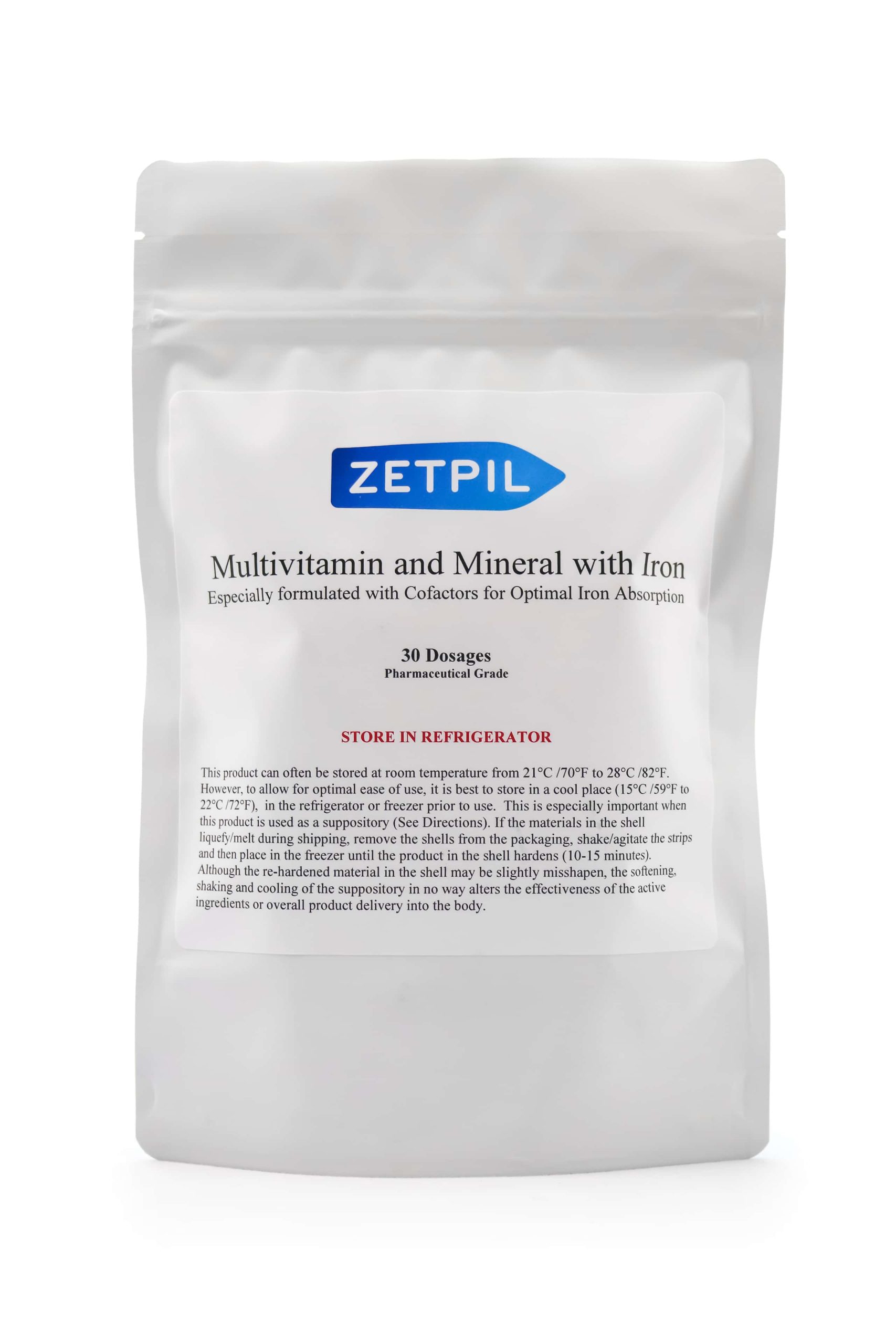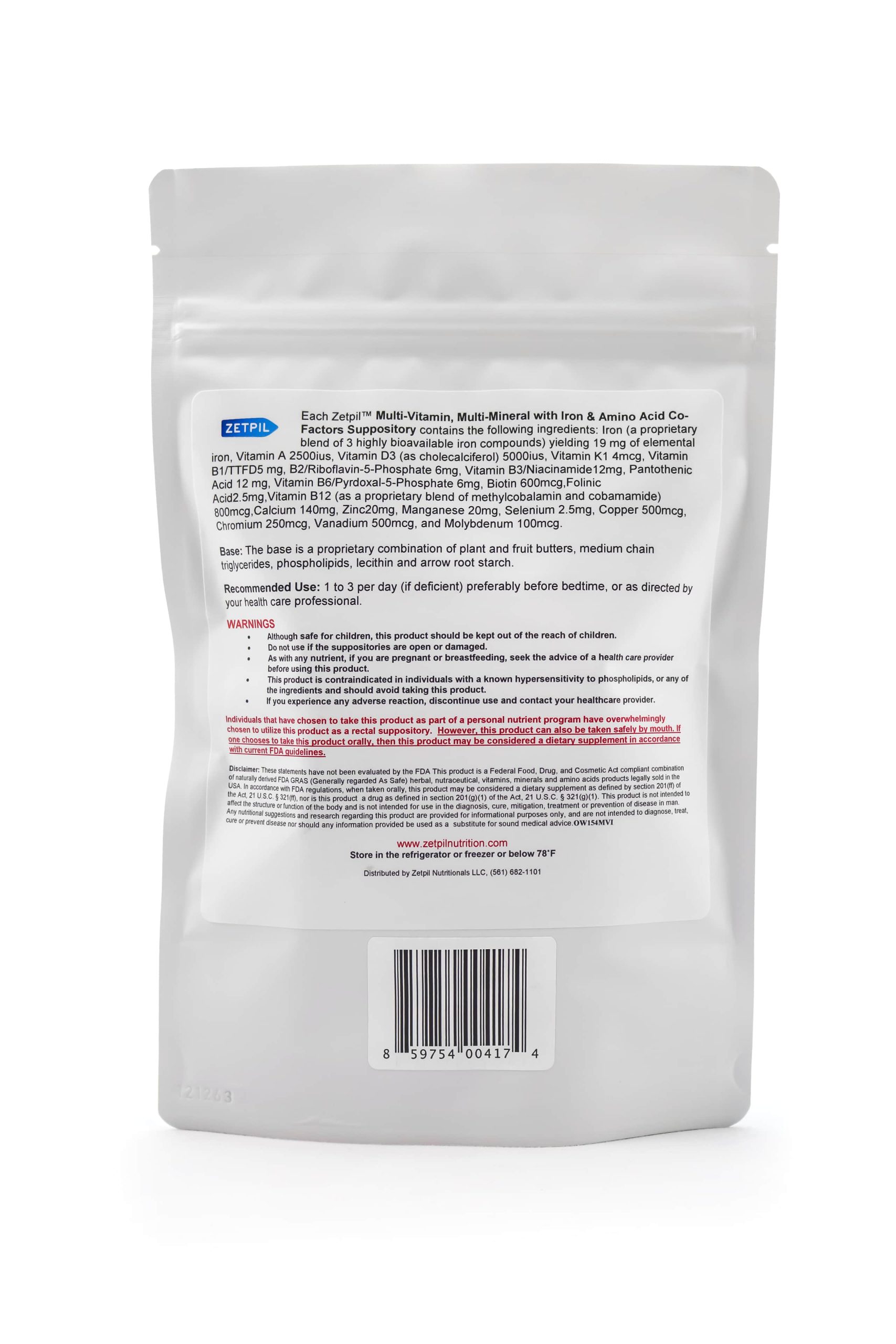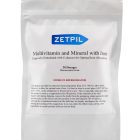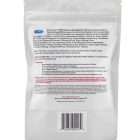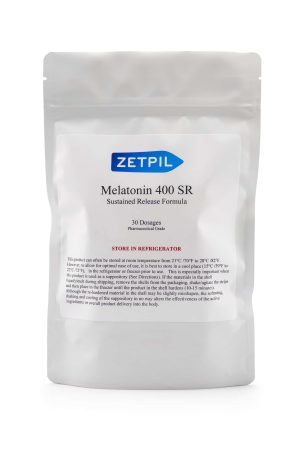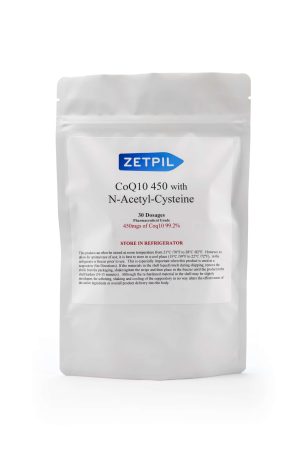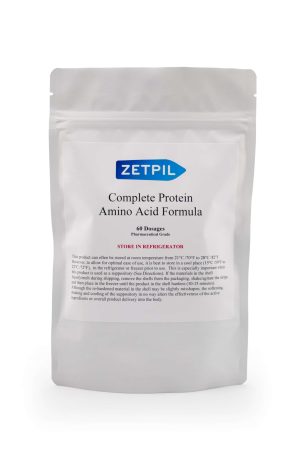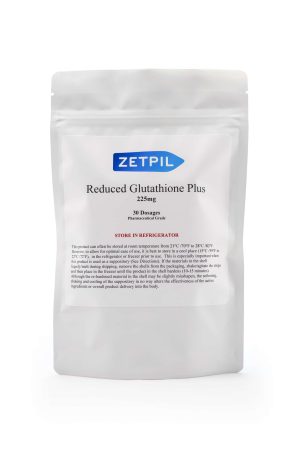Description
Zetpil™ Suppository Advantage
Zetpil™ delivers nutrition via the rectum with the use of suppositories that have a unique, all- natural formulated base that has revolutionized not only this mode of delivery, but also the ability to obtain nutrients in a far more efficacious method. These suppositories are a result of combining natural ingredients with a non-irritating, rapid melting (5-6 minutes), readily absorbable (superior retention), antioxidant base material (free radical scavenging ability) and delivers the nutrients directly into the bloodstream in less than 20 minutes in a highly effective manner. Oral supplements are exposed to the hazards of stomach acid, digestive enzymes, food-related breakdown, first pass metabolism, and other bioavailability issues in the gastro-intestinal system.
Additionally, many raw materials simply have a very low bioavailability , and only achieve around 10% or less (commonly <1%) absorption rates, even if the patient is in optimal health condition. Compromised health, age, or certain conditions that result in an inability to take oral nutrients often preclude these patient populations from obtaining the necessary nutrition to stay healthy which often exacerbates chronic health issues.
Zetpil™ suppositories are a NOW solution to delivering the necessary nutrients to patients, on a daily basis, that is both easy, comfortable and cost effective. The safety and noticeable effectiveness of these products will far outweigh any initial hesitation you have regarding this mode of delivery.
Why the Zetpil™ Multivitamin and Mineral with Iron Product works
Many individuals cannot tolerate oral iron supplements and most experience a number of adverse reactions which force them to stop taking iron. Also, poor absorption of oral supplements is a frustrating failure in many medical conditions where individuals suffer from chronic malabsorption.
Non-laxative rectal suppositories have been used to deliver medications since the 1840s. The general principle is that the suppository, used after a bowel movement, is inserted in its tapered form blunt side first and then dissolves inside the rectum delivering the compounds inside the suppository form into the body. The compounds within the suppository are absorbed directly into the bloodstream.
Exploring and building on this fundamental concept, the Zetpil™ research team developed the Multivitamin & Mineral with Iron suppository. Logically, it made more sense to avoid the damaged or compromised structures involved in oral iron absorption by the delivery of the iron, and the essential nutrient co-factors required for optimal absorption, directly into the body via this alternative route.
Although this common sense approach seems simple enough, it has taken our research team 5 years and countless hours of tireless research to develop an all-natural suppository that was safe, effective, comfortable, hypo-allergenic and essentially side-effect free. This innovative suppository delivers:
- the highest quality vitamins and minerals in a specialized combination of highly absorbable forms of iron,
- the most bioactive forms of the B vitamins and the specialized forms of B12, pure methylcobalamin and adenylcobalamin,
- specialized mineral micronutrients, and
- the specific amino acids needed in the conversion of elemental iron to resolve Iron Deficiency Anemia (IDA) as well as anemia due to a deficiency of other essential nutrients.
The Zetpil™ Multivitamin & Mineral with Iron suppository has been shown to be effective in as little as 6-8 weeks. However, it is important to keep in mind that iron deficiencies cannot be corrected overnight and depending on the extent of the deficiency it may take up to 6 months of iron supplementation to replenish the iron that your body needs to function properly.
Anemia
Anemia: Still a Problem in the 21st Century
Iron-deficiency anemia is the most widespread nutrient deficiency in the world, affecting an estimated 2 billion people worldwide. Anemia impairs immunity and reduces physical and mental capacities. This deficiency affects people of all ages and the side effects of anemia are common yet also debilitating. They include, but are not limited to:
• Fatigue
• Trouble breathing
• Rapid heartbeat and/or chest pain
• Light-headedness and/or dizziness
• Inability to concentrate
• Headache
• Inability to stay warm
• Pale skin
Accordingly, iron deficiency is a major public health problem worldwide with enormous social and economic costs. Below is a list of market facts that highlight the need for Zetpil™’s revolutionary and innovative Multivitamin and Mineral with Iron product.
The Facts
The Facts
The Facts
Cancer-Related Anemia
80% of chemotherapy patients have severe, debilitating anemia
…“the results obtained from clinical trials showed that the probability of mild anemia incidence after the use of chemotherapy is 100%, while the probability of severe anemia incidence after chemotherapy is 80%.”http://www.apocpcontrol.org/paper_file/issue_abs/Volume12_No10/2753-58%20c%206.23%20Bassam.pdf
**Current medical recommendations for anemic cancer patients have serious side effects and FDA warnings, dating back to 2007. Caution is urged when considering the use of these interventions. http://www.fda.gov/Drugs/DrugSafety/PostmarketDrugSafetyInformationforPatientsandProviders/ucm109375.htm
Gastric-Bypass Patients
Iron deficiency is common after gastric bypass surgery with reports of deficiencies up to 51% post surgically. In patients undergoing Roux en Y Gastric Bypass (RYGB), 35-74% of patients demonstrated anemia unresponsive to oral nutritional supplementation.http://www.ncbi.nlm.nih.gov/pmc/articles/PMC2856827/pdf/WJG-15-1867.pdf, http://ajcn.nutrition.org/content/90/3/527.full.pdf
Heart Failure Patients
17-48% of patients with heart failure have anemia
“Iron therapy was associated with significant improvements in physical functioning in iron-deficient patients with heart failure, even in non-anaemic patients.” http://www.ncbi.nlm.nih.gov/pmc/articles/PMC3403475/pdf/hfs056.pdf
Teenagers
“Teens go through rapid growth spurts…and they can be at risk for iron deficiency anemia. During a growth spurt, the body has a greater need for all types of nutrients, including iron. Girls are at more risk of iron deficiency anemia due to menstruation.” http://kidshealth.org/teen/diseases_conditions/blood/anemia.html
Rheumatoid Arthritis Patients
2.1 million Americans have rheumatoid arthritis. People with rheumatoid arthritis may acquire iron deficiency anemia or anemia of chronic disease. 30-60% of rheumatoid arthritis patients have anemia.
“Iron metabolism is impaired in chronic inflammatory diseases such as RA,” and the “frequency of iron deficiency was over 50% in RA patients.” https://www.jstage.jst.go.jp/article/internalmedicine/48/6/48_6_421/_pdf
Restless Leg Syndrome
It is estimated that 21 to 45 million people in the US suffer from Restless Leg Syndrome, which can often be resolved by restoring adequate iron stores. http://www.ncbi.nlm.nih.gov/pmc/articles/PMC3069701/pdf/awr012.pdf
Crohn’s Disease, Inflammatory bowel disease (IBD) and Ulcerative Colitis
10-72% of Crohn’s disease patients, 8-74% of ulcerative colitis sufferers and 17-41% of all types of Inflammatory Bowel Disease (IBD)patients have anemia. http://www.ncbi.nlm.nih.gov/pmc/articles/PMC3413990/pdf/GRP2012-595970.pdf – http://www.ncbi.nlm.nih.gov/pmc/articles/PMC2817021/pdf/0950199.pdf
Problems with Iron Replacement
Problems Associated With Intramuscular or Intravenous Iron Replacement Therapy
The use of intramuscular or intravenous therapy is reserved for individuals that are severely anemic. The use of Intramuscular injections, although still done, has fallen into disfavor by many in the medical community because intramuscular iron injections requires a relatively high degree of skill and care to administer, are usually quite painful, patients often experience permanent scaring over the site of the healed injections, and they are no safer than intravenous therapy. http://theoncologist.alphamedpress.org/content/16/suppl_3/25.full.pdf
Intravenous iron therapy also poses risks and potential side effects and is generally reserved for patients who are iron deficient with hemoglobin levels at or below 8.0 g/dl. In the case of chronic malabsorption, individuals with chronic Iron deficiency Anemia (IDA) who receive intravenous iron dextrin therapy are often unable to maintain their levels with follow-up daily doses of oral iron supplements and therefore require repeated intravenous iron treatments as they develop iron deficient anemia over and over again.
Prior to the development of the Zetpil™ Multivitamin & Mineral with Iron, an individual with recurrent iron deficient anemia had no option but to suffer while they progressively became sicker and until their levels again were low enough to justify treatment with intravenous iron replacement treatments. This slow and progressive drop in iron levels and hemoglobin often takes months, while the iron deficient individual suffers from the debilitating symptoms of iron deficient anemia. As you might imagine, this combination of chronic illness and repetitive therapy takes both a physical and emotional toll.
Another complication that occurs in individuals who are required to undergo recurrent intravenous iron therapy to treat this “anemia rollercoaster” is the collapse of the veins used for the intravenous therapy. Often these patients will require the use of either a Peripherally Inserted Catheter (PIC) or a Central Venous Line (CVL) with all the discomfort, inconvenience and complications associated with those procedures. Again this is a significant problem with patients who have undergone Gastric Bypass Surgery procedures as well as other patients with medical conditions with chronic malabsorption that require recurrent iron infusions.
A similar dilemma occurs in individuals who are clearly anemic and significantly symptomatic but the levels are not low enough (Hemoglobin at/or below 8 g/dl) to warrant exposing the individual to the risks and potential side effects of intramuscular or intravenous iron replacement therapy. However, because these individuals do not respond adequately to oral iron replacement therapy, these individuals are trapped in the painfully symptomatic and debilitating world of permanent iron deficiency anemia. For those who suffer from medical conditions such as Celiac Disease, Crohn’s Disease, Cystic Fibrosis, Fibromyalgia, Restless Leg Syndrome, or cancer, where nutrient malabsorption is a problem, this can be physically and emotionally draining. Until the development of the Zetpil™ Multivitamin & Mineral with Iron Suppository, an individual’s options with this condition were quite limited.
Precautions
Precautions
General: Do not exceed recommended dose. The type of anemia and the underlying cause or causes should be determined before starting therapy, which is easily achieved with simple blood tests. Since the anemia may be a result of a systemic disturbance, such as recurrent blood loss, the underlying cause or causes should be addressed and corrected.
Folic Acid: 1 mg of folic acid as folinic acid is contained in this product. Although folic acid in doses above 1.0 mg daily may obscure B12 dependent pernicious anemia in that hematologic remission can occur while neurological manifestations remain progressive, this product contains vitamin B12 in its 2 most bioactive forms. Therefore, the potential for folic acid to mask the symptoms of pernicious anemia is to be minimal.
Pediatric Use: Safety and effectiveness in pediatric patients have not been clearly established. Therefore seek the advice of a healthcare professional before using.
Geriatric Use: Clinical studies on this product have not been performed in sufficient numbers of subjects aged 65 and over to determine whether elderly subjects respond differently from younger subjects. Therefore, dose selection for an elderly patient should be cautious, usually starting at the low end of the dosing range (1 suppository per day). Higher dosages should reflect decreased hepatic, renal, or cardiac function, and of concomitant disease or other drug therapy.
Adverse Reactions: Adverse reactions with both oral and parenteral iron therapy may include constipation, diarrhea, nausea, vomiting, dark stools and abdominal pain. Allergic sensitization has been reported following both oral and parenteral administration of folic acid. However, significantly less allergic sensitivity and constipation, diarrhea, nausea, vomiting, dark stools and abdominal pain have been demonstrated in extensive clinical usage with rectal administration of these specialized forms of iron.
Over-Dosage: The clinical course of acute iron over-dosage can be variable. Initial symptoms may include abdominal pain, nausea, vomiting, diarrhea, tarry stools, melena, hematemesis, hypotension, tachycardia, metabolic acidosis, hyperglycemia, dehydration, drowsiness, pallor, cyanosis, lassitude, seizures, shock and coma.
Contraindications: This product is contraindicated in patients with a known hypersensitivity phospholipids, sesame seeds or any of the ingredients. Hemochromatosis and hemosiderosis are contraindications to iron therapy.
Supplement Facts
Supplement Facts
Serving Size: 1 suppository
Servings Per Container: 30
Amount Per Serving
Iron (a proprietary blend of 3 highly bioavailable iron compounds) 19 mg Elemental Iron
Vitamin A 2500 ius
Vitamin D3 (as cholecalciferol) 5000 ius
Vitamin B1/TTFD 5 mg
Vitamin B2/ Riboflavin-5-Phosphate 6 mg
Vitamin B3/Niacinamide 12 mg
Vitamin B6/ Pyrdoxal-5-Phosphate 6 mg
Biotin 600 mcg
Folinic Acid 2.5 mg
Vitamin B12 (as a proprietary blend of methylcobolamin and cobamamide) 800 mcg
Pantothenic Acid 12 mg
Zinc 20 mg
Manganese 20 mg
Selenium 2.5 mg
Copper 500 mcg
Chromium 250 mcg
Vanadium
Calcium 140 mg
Molybdenum 100 mcg
Suppository Base: The base is a proprietary combination of plant and fruit butters, medium chain triglycerides, phospholipids, lecithin and arrow root starch.
Recommended use: 1 to 3 (if deficient) per day, preferably before bedtime, or as directed by your health care provider.
This product contains NO milk, egg, fish, peanuts, crustacean shellfish (lobster, crab, and shrimp), tree nuts, wheat, yeast, gluten, corn, rice, sugar, artificial sweeteners, flavors, colors, or preservatives.
This product is contraindicated in individuals with a known hypersensitivity to phospholipids, or any of the listed ingredients.
Due to the nature of the product suppositories cannot be returned or exchanged.
WARNINGS:
- Although safe for children, this product should be kept out of the reach of children.
- Do not use if the suppositories are open or damaged.
- As with any nutrient if you are pregnant or breastfeeding, seek the advice of a health care provider before using this product.
- Individuals that have chosen to take this product as part of a personal nutrient program have overwhelmingly chosen to utilize this product as a rectal suppository. However, this product can also be taken safely by mouth. If one chooses to take this product orally, then this product may be considered a dietary supplement in accordance with current FDA guidelines.
Disclaimer: These statements have not been evaluated by the FDA. This product is a Federal Food, Drug, and Cosmetic Act compliant combination of naturally derived FDA GRAS (Generally regarded As Safe) herbal, nutraceutical, vitamins, minerals and amino acids products legally sold in the USA. In accordance with FDA regulations, when taken orally, this product may be considered a dietary supplement as defined by section 201(ff) of the Act, 21 U.S.C. § 321(ff).
Also, this product consists ONLY of a combination of naturally derived FDA GRAS (Generally regarded As Safe) herbal, nutraceutical, vitamins, minerals and amino acids products legally sold in the USA. Therefore, this product cannot be considered a drug as defined in section 201(g)(1) of the Act, 21 U.S.C. § 321(g)(1). This product is not intended to affect the structure or function of the body and is not intended for use in the diagnosis, cure, mitigation, treatment or prevention of disease in man. Any nutritional suggestions and research regarding this product are provided for informational purposes only, and are not intended to diagnose, treat, cure or prevent disease nor should any information provided be used as a substitute for sound medical advice.
References
References
Cancer-related anemia: biological findings, clinical implications and impact on quality of life
Oncology 2005; 68 Suppl 1:12-21
Blohmer JU, et al
http://www.ncbi.nlm.nih.gov/pubmed/15855812
Parenteral iron therapy in cancer-associated anemia
Hematology Am Soc Hematol Educ Program 2010; 2010:351-6
Henry DH.
http://asheducationbook.hematologylibrary.org/content/2010/1/351.long
The burden of blood transfusion: a utilization and economic analysis–a pilot study in patients with chemotherapy-induced anemia (CIA)
J Med Econ 2013; 16(5):633-8
Reitan JF
http://www.ncbi.nlm.nih.gov/pubmed/23425291
Clinical Use of Intravenous Iron: Administration, Efficacy, and Safety
Michael Auerbach and Harold Ballard
Hematology Am Soc Hematol Educ Program 2010; 2010:338-47
http://asheducationbook.hematologylibrary.org/content/2010/1/338.full.pdf
Venous Thromboembolism and Mortality Associated With Recombinant Erythropoietin and Darbepoetin Administration for the Treatment of Cancer-Associated Anemia
Charles L. Bennett, MD, PhD
JAMA 2008; 299(8):914-924
http://jama.jamanetwork.com/article.aspx?articleid=181533
Incidence and risk factors for the development of anemia following gastric bypass surgery
World J Gastroenterol Apr 21, 2010; 16(15): 1867–1870
Dimitrios V Avgerinos
http://www.ncbi.nlm.nih.gov/pmc/articles/PMC2856827/
Hematological Disorders following Gastric Bypass Surgery: Emerging Concepts of the Interplay between Nutritional Deficiency and Inflammation
Biomed Res Int. 2013; 2013: 205467
Mingyi Chen, et al
http://www.ncbi.nlm.nih.gov/pmc/articles/PMC3741944/
Profile of altered brain iron acquisition in restless legs syndrome
Connor JR, Ponnuru P, Wang XS, Patton SM, Allen RP, Earley CJ.
Brain 2011 Apr; 134(Pt 4):959-68
http://www.ncbi.nlm.nih.gov/pmc/articles/PMC3069701/pdf/awr012.pdf
Prevalence of anaemia in older persons: systematic review
Gaskell H, Derry S, Andrew Moore R, McQuay HJ
BMC Geriatr 2008 Jan 14; 8:1
http://www.ncbi.nlm.nih.gov/pmc/articles/PMC2248585/pdf/1471-2318-8-1.pdf
Prevalence of anaemia in older persons: systematic review
Gaskell H, Derry S, Andrew Moore R, McQuay HJ
BMC Geriatr 2008 Jan 14; 8:1
http://www.ncbi.nlm.nih.gov/pmc/articles/PMC2248585/pdf/1471-2318-8-1.pdf
http://kidshealth.org/teen/diseases_conditions/blood/anemia.html

